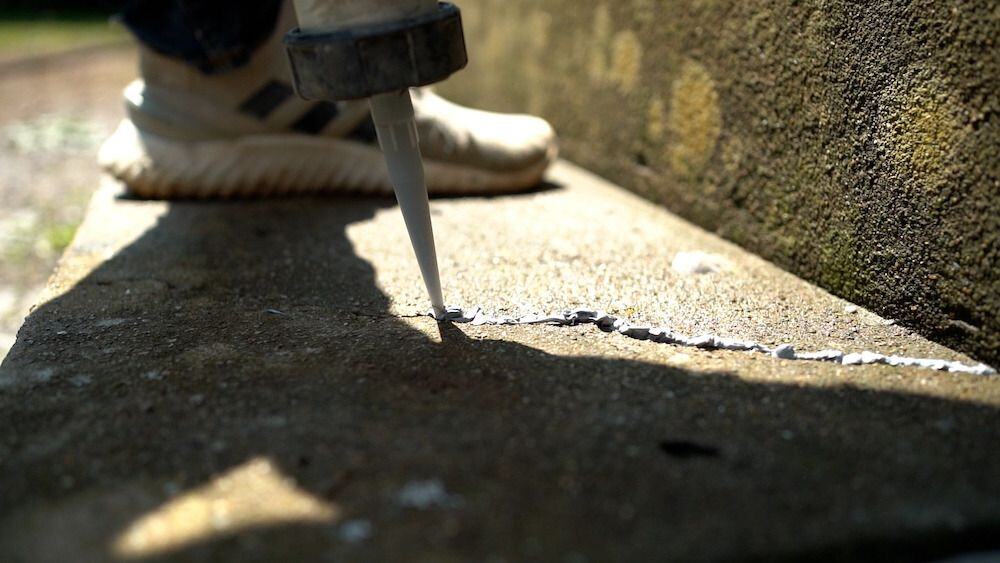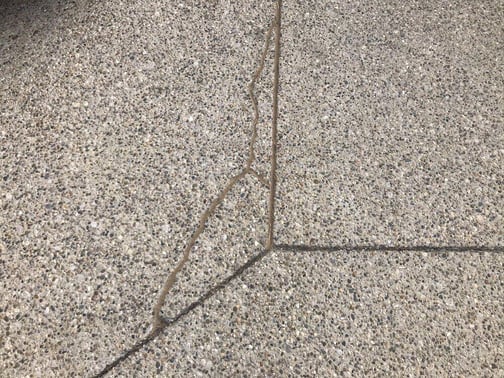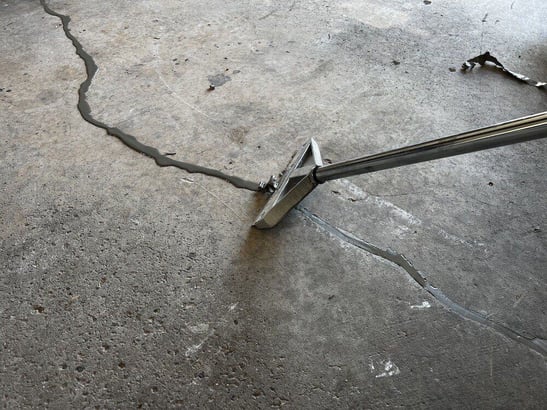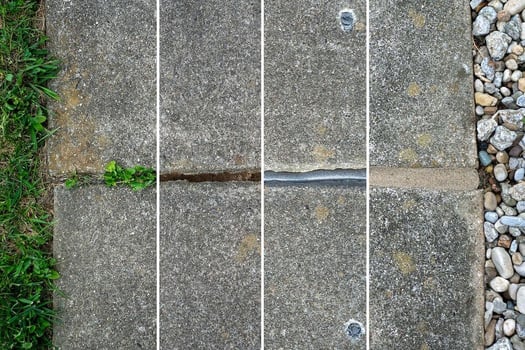
Learn everything you need to know about fixing cracks in concrete.
Concrete cracks aren’t just an eyesore – they can cause your slabs to settle, weeds to grow free, and the concrete to break down prematurely.
So, if concrete cracks are so bad, what can you do about them?
In this article, we’re sharing everything we know about fixing concrete cracks from over 30+ years in the concrete repair and maintenance industry.
By the end, you’ll have a good idea of how to tackle your concrete cracks. Let’s get started!
Types of Concrete Crack Repair
There are many ways to fix concrete cracks. Here are some of the different concrete crack repair materials and methods available:
Flexible Concrete Caulk
Concrete caulk is specifically designed to adhere to the roughness of concrete rather than smooth surfaces, and flex with the concrete’s natural expansion and contraction due to temperature changes and moisture retention in outdoor conditions.
Non-sag and self-leveling concrete caulk are two options that are often used together to achieve a better-looking final result. If you plan to DIY your repair, pay attention to which one you get as the application process for each is a little different.
Polyurea Crack Filler
Polyurea is a two-part, fast-setting, semi-rigid repair liquid used to mend cracks in concrete and repair spalled or damaged joints.
Using polyurea on concrete cracks can help reinforce the breaks and strengthen the concrete. There is a lot of prep work involved in using polyurea to repair cracks, which can make it difficult to DIY.
Epoxy
Epoxy crack filler is similar to polyurea in that it is a two-component material. It’s also sandable and can help reinforce the crack rather than only seal it up.
There are some DIY epoxy products available, but the best option when using epoxy to fix garage cracks is to get it done professionally due to the prep work involved and the more complicated process compared to traditional caulking products.
Concrete Patch
Concrete patch products available at big box stores are another option and are relatively inexpensive, but they are usually only temporary.
Rigid concrete patches cannot properly bond with the existing concrete, and as the concrete expands, contracts, and moves, it ends up cracking and chipping off, sometimes in only a matter of a few months.
Mortar or Grout
Similarly to concrete patches, adding mortar and grout to concrete cracks is only a temporary fix.
As the concrete moves and shifts daily with changing temperatures, the rigid mortar or grout doesn’t flex with it. This causes it to crack off or crumble away very quickly.

Best Fix for Cracked Concrete
The best way to repair concrete cracks will depend on the area with the cracks and the overall goals of the repair.
Exterior Slabs
Flexible concrete caulk is best for exterior slabs that are exposed to water and freeze-thaw cycles (think driveways, sidewalks, patios) as they keep moisture out and move with the concrete.
You should avoid adding rigid materials such as mortar, grout, or extra concrete to exterior cracks, as they don’t move and flex with the concrete and end up cracking off.
Interior Slabs
Interior slabs that will later be covered (think a garage floor being prepped for an epoxy coating) are better suited for epoxy or polyurea crack fillers as they can be shaved down for a smooth surface, and the concrete undergoes less movement due to the controlled environment.
Another common place you might see an epoxy or polyurea crack repair is in a big box retail or grocery store.
Pro Tip: Always check to make sure your crack filler is compatible with the coating, or check with your coating installer before attempting your own crack repair.
How To Fix Cracks in Concrete
Fixing concrete cracks looks different in different locations. This section will provide an overview of how to fix concrete cracks in each of these areas + links to more in-depth guides.
Driveway Crack Repair
To caulk cracks or gaps in a concrete driveway, use a flexible concrete caulk and follow these steps:
- Clean out the crack
- Install sand or backer rod to fill the void and limit the amount of caulk needed (max ½-inch)
- Apply the caulk to the crack
- Smooth out the caulk with soap and water
- Add sand or small rocks for color and texture
Related Resource: Concrete Driveway Crack Repair – DIY Guide
Garage Crack Repair
Repairing cracks in a garage floor can be done with epoxy, polyurea, or flexible concrete caulk, and there are unique benefits to each. For installing epoxy and polyurea crack fillers, follow these steps:
- Grind the cracks so there are uniform edges for the crack filler to bond to
- Clean any dust, chunks of concrete, and debris from the cracks
- Add crack filler to the crack, overflowing it slightly
- Scrape or shave down the excess material from the filled crack
Related Resource: How to Fix Cracks in a Garage Floor
Sidewalk Crack Repair
Sidewalk slabs often settle and crack, creating an uneven surface to work with when repairing cracks.
For that reason, it’s important to lift the settled slabs with concrete leveling to get the edges of the crack even before attempting to repair it with the same steps as the driveway crack repair above.
Related Resource: Sidewalk Crack Repair - DIY Guide

Narrow vs. Wide Crack Repair
Repairing small, narrow cracks is different from wider, gaping cracks.
Narrow Cracks
Narrow cracks – less than ¼-inch wide – can usually be repaired simply by filling the gap with concrete caulk.
Oftentimes, small hairline cracks or tiny interior cracks that aren’t exposed to water and freeze-thaw cycles don’t need repair at all (as long as they are not getting worse).
Related Resource: Types of Concrete Cracks + What They Mean
Wide Cracks
Wide cracks – wider than ¼ inches – can still be caulked and repaired, but they often will need a foam backer rod, sand, or some sort of “filler” to go in the crack before the repair material.
This foam or sand fills up the voids and gaps within the crack so you use less caulk or repair material. It also acts as a support to hold the repair material in place while it is curing and helps ensure the material has the proper thickness and shape.
The wider the crack, the more important using foam backer rod or another filler becomes.
Pro Tip: You can use a pool noodle as backer rod if you don’t mind cutting it to the right size.
DIY vs. Professional Concrete Crack Repair
The following factors are usually the biggest things to consider when deciding on whether to repair concrete cracks yourself or hire a professional:
Aesthetics
Professionals repair cracks and caulk concrete day in and day out, so they know the tricks of the trade when it comes to making the final product look great. And, as the saying goes, “practice makes perfect.”
With that being said, there are many DIY guides and tutorials on the internet that can help you get a nice-looking final result if you take your time.
Time
While a professional is at work, you can be doing other things – you may not even have to be on-site when the crack repair is being done.
DIY-ing concrete crack repair involves research, finding and buying materials, prep work, the crack repair itself, and clean up. A couple of hours of professional work can easily take up an entire weekend as a DIY.
Cost
Where DIY crack repair really shines is cost savings. If you already have the tools at home to repair cracks (picks, wire brushes, angle grinder, etc.), you’ll really only need to purchase the crack repair material.
For exterior slabs, you can expect to pay $10-12 for a tube of decent concrete caulk (although epoxy, polyurea, and other products are often double the cost or more).
Related Resource: Concrete Driveway Repair Costs in 2024 – DIY and Professional

How Long Does Concrete Crack Repair Last?
Each concrete crack repair material, method, and situation is different, so there is no one-size-fits-all answer to how long concrete crack repair lasts.
With any crack repair solution, you’ll need to regularly check to make sure it is still protecting your concrete.
For example, caulk that has dried up or is pulling away from the sides of the crack is no longer maintaining a watertight seal and will need to be replaced or touched up.
Concrete Crack Repair FAQ
Which is the most common method of crack repair?
Most cracks in exterior concrete slabs (driveways, sidewalks, patios, etc.) are filled with flexible concrete caulk. Depending on the goal of your particular application inside (garage, basement, concrete floor, etc.) concrete caulk may also be used indoors.
Does concrete sealer fix cracks?
No, concrete sealer does not fix cracks.
Concrete sealer is a coating that goes over the entire concrete surface (topical) or absorbs into the concrete’s pores (penetrating) to protect the concrete’s surface – not to fill and fix cracks. In fact, some concrete sealers can make the cracks even more noticeable.
Instead, crack filler and concrete caulk are specifically designed to fill gaps and cracks. Not only can this help protect the concrete from worsening damage and settling, but it can also help blend in the cracks with the concrete depending on the finishing technique used.
Related Resource: Why Should You Repair Concrete Cracks?
What materials are used to repair concrete cracks?
Flexible polymer caulks, polyurea crack fillers, and epoxy crack fillers are common materials used to repair concrete cracks. Each material has its own pros and cons, and which one you choose will depend on the end goal of your project.
How Should You Repair Your Concrete Cracks?
Whatever the method you choose for repairing concrete cracks, it’s an important part of regular concrete maintenance that can keep your concrete looking great for longer.
Where the concrete cracks are (interior, exterior, garage, sidewalk, etc.) will determine the best repair type for your concrete.
At the end of the day, getting the opinion of a concrete repair expert will help determine the best approach for your unique situation. Here at A-1, we’ve been repairing and protecting our customers’ concrete for 30+ years
If you’d like to learn more about A-1’s professional concrete caulking services and get an expert opinion on your concrete cracks, request a free onsite cost estimate!
Related Resource: How to Fix Cracks in a Garage Floor
Let the caulk set completely
Related Resource: Concrete Driveway Crack Repair – DIY Guide
Garage Crack Repair
Repairing cracks in a garage floor can be done with epoxy, polyurea, or flexible concrete caulk, and there are unique benefits to each. For installing epoxy and polyurea crack fillers, follow these steps:
Grind the cracks so there are uniform edges for the crack filler to bond to
Clean any dust, chunks of concrete, and debris from the cracks
Add crack filler to the crack, overflowing it slightly
Scrape or shave down the excess material from the filled crack
Let the crack filler fully cure before using the garage like normal
Related Resource: How to Fix Cracks in a Garage Floor
Sidewalk Crack Repair
Sidewalk slabs often settle and crack, creating an uneven surface to work with when repairing cracks.
For that reason, it’s important to lift the settled slabs with concrete leveling to get the edges of the crack even before attempting to repair it with the same steps as the driveway crack repair above.
Sarah Etler joined A-1 Concrete Leveling after receiving her Bachelor of Arts degree in English from Northern Kentucky University. As A-1's Content Marketing Manager, she works closely with industry experts to produce content that will best answer questions related to concrete repair and maintenance practices. Sarah loves living a life full of discovery and is excited every day to see what new things she can learn and share with those around her.
Topics: